LG LMX21981, LMX21971, LMX2525971, LMX25981 User Manual
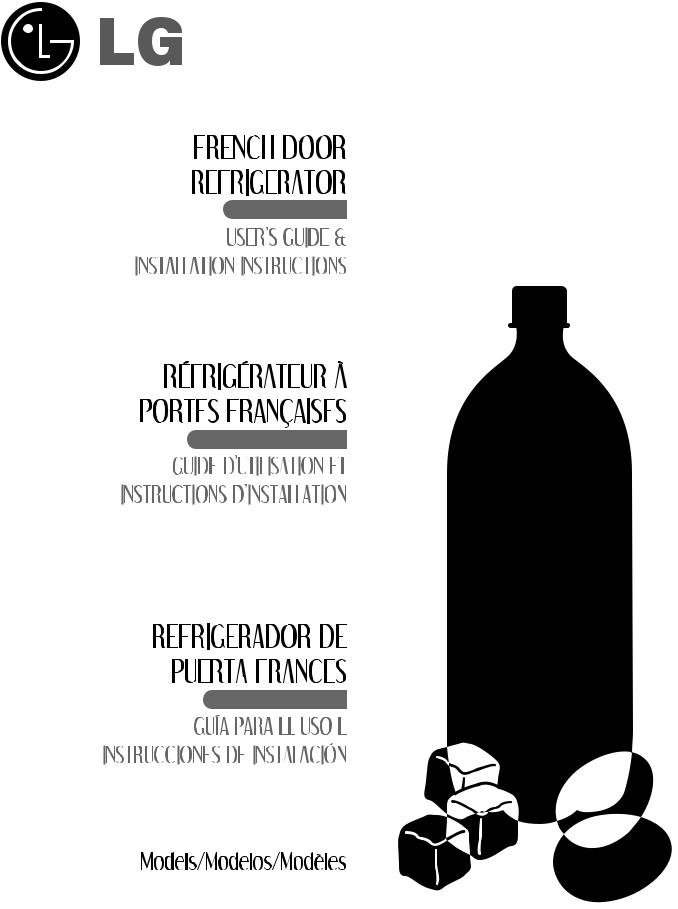
To contact LG Electronics, 24 hours a day, 7 days a week:
1-800-243-0000
Or visit us on the Web at: us.lge.com
Pour contacter LG Electronics, 24 heures par jour, 7 jours par semaine:
1-800-243-0000
Ou visitez notre site Web à l’adresse: us.lge.com
Para comunicarse con LG Electronics, 24 horas al día, 7 días a la semana:
1-800-243-0000
O visítenos en la Web en: us.lge.com
Please read this guide thoroughly before operating and keep it handy for reference at all times.
Veuillez lire ce guide attentivement avant la mise en service de l’appareil et gardez-le à portée de main pour le consulter en cas de besoin.
Lea detenidamente estas instrucciones antes utilizar el frigorífico y guárdelas como referencia para el futuro.
LMX25981**, LMX21981**
P/No. MFL37933514

IMPORTANT SAFETY INFORMATION
Basic Safety Precautions ........................................ |
3 |
CFC Disposal .......................................................... |
4 |
How to Connect Electricity ...................................... |
5 |
PARTS AND FEATURES |
|
Special Features ..................................................... |
6 |
Key Parts and Components .................................... |
7 |
INSTALLATION |
|
Choose the Proper Location ................................... |
8 |
Clearances .............................................................. |
8 |
Flooring ................................................................... |
9 |
Handle Removal...................................................... |
9 |
Door and Drawer Removal.................................... |
10 |
Connecting the Water Supply ............................... |
18 |
Connecting the Water Lines.................................. |
18 |
Leveling the Refrigerator Doors ............................ |
20 |
Starting.................................................................. |
21 |
HOW TO USE |
|
Control Panel Features ......................................... |
22 |
The LED Display ................................................... |
23 |
Adjusting the Temperatures and Display ............. |
24 |
Operating the Dispenser ...................................... |
25 |
Setting the Functions ........................................... |
26 |
In-Door Ice Bin ..................................................... |
27 |
Automatic Icemaker ............................................. |
28 |
Storing Foods ....................................................... |
29 |
Location of Foods ................................................. |
30 |
Shelf Height Adjustment ....................................... |
31 |
CARE AND CLEANING |
|
Removing and Replacing Components ................ |
32 |
Cleaning the Refrigerator ..................................... |
35 |
General Information ............................................. |
35 |
Replacing the Water Filter..................................... |
36 |
TROUBLESHOOTING
Before Calling for Service …………………………37
SPECIFICATIONS |
|
Key Dimensions and Specifications ..................... |
41 |
WARRANTY |
|
Product Registration Information .......................... |
42 |
THANK YOU!
Congratulations on your purchase
and welcome to the LG family.
Your new LG French Door
Refrigerator combines
advanced cooling technology
with simple operation and high
efficiency. Follow the operating
and care instructions in this
this manual and your refrigerator
will provide you with many years
of reliable service.
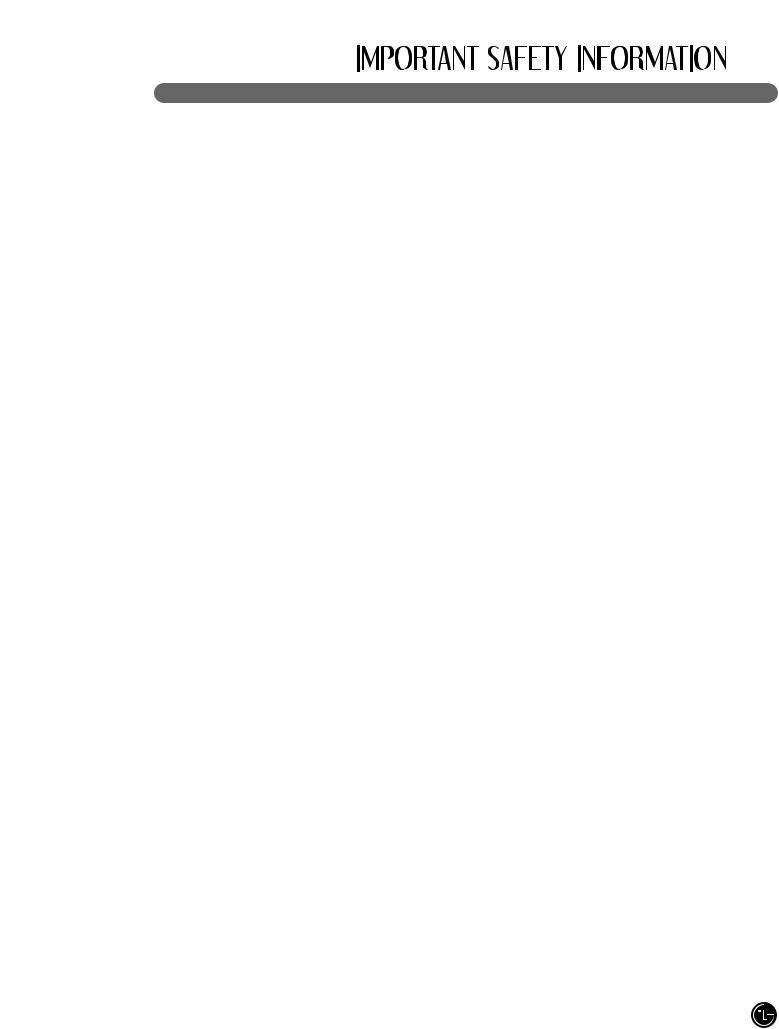
 BASIC SAFETY PRECAUTIONS
BASIC SAFETY PRECAUTIONS
This guide contains many important safety messages. Always read and obey all safety messages.
w This is the safety alert symbol. It alerts you to safety messages that inform you of hazards that can kill or hurt you or others or cause damage to the product. All safety messages will be preceded by the safety alert symbol and the hazard signal word DANGER, WARNING, or CAUTION. These words mean:
wDANGER wWARNING
wCAUTION
You might be killed or seriously injured if you don’t follow instructions.
You can be killed or seriously injured if you don’t follow instructions.
Indicates an imminently hazardous situation which, if not avoided, may result in minor or moderate injury, or product damage.
All safety messages will identify the hazard, tell you how to reduce the chance of injury, and tell you what can happen if the instructions are not followed.
wWARNING
To reduce the risk of fire, electric shock, or injury to persons when using your product, basic safety precautions should be followed, including the following.
Read all instructions before using this appliance.
•NEVER unplug your refrigerator by pulling on the power cord. Always grip the plug firmly and pull it straight out from the outlet.
•Repair or replace immediately all electric service cords that have become frayed or otherwise damaged. Do not use a cord that shows cracks or abrasion damage along its length or at either the plug or connector end.
•When moving your refrigerator away from the wall, be careful not to roll over or damage the power cord.
•DO NOT store or use gasoline or other flammable vapors and liquids in the vicinity of this or any other appliance.
•Do NOT allow children to climb, stand, sit or hang on doors, drawers or shelves of the refrigerator. They could damage the refrigerator and seriously injure themselves.
•Keep fingers out of pinch point areas; clearances between the doors and cabinet are necessarily small. Be careful closing doors when children are in the area.
•Unplug your refrigerator before cleaning or making any repairs.
NOTE: Service should be performed by a qualified technician.
•Before replacing a burned-out light bulb, unplug the refrigerator or turn off power at the circuit breaker or fuse box in order to avoid contact with a live wire filament. (A burned-out light bulb may break when being replaced.)
NOTE: Some models have LED interior lighting and service should be performed by a qualified technician.
NOTE: Setting either or both controls to the OFF position does not remove power to the light circuit.
•When you are finished, reconnect the refrigerator to the electrical source and reset the control (Thermostat Refrigerator Control, or Freezer Control, or Freezer Control, depending on the model) to the desired setting.
•This refrigerator must be properly installed in accordance with the Installer Instructions that were taped to the front of the refrigerator.
•After your refrigerator is in operation, do not touch the cold surfaces in the freezer compartment when hands are damp or wet. Skin may adhere to the extremely cold surfaces.
•In refrigerators with automatic icemakers, avoid contact with the moving parts of the ejector mechanism or with the heating element that releases the cubes. DO NOT place fingers or hands on the automatic icemaking mechanism while the refrigerator is plugged in.
•Do not modify or extend the power cord length.
It will cause electric shock or fire.
3
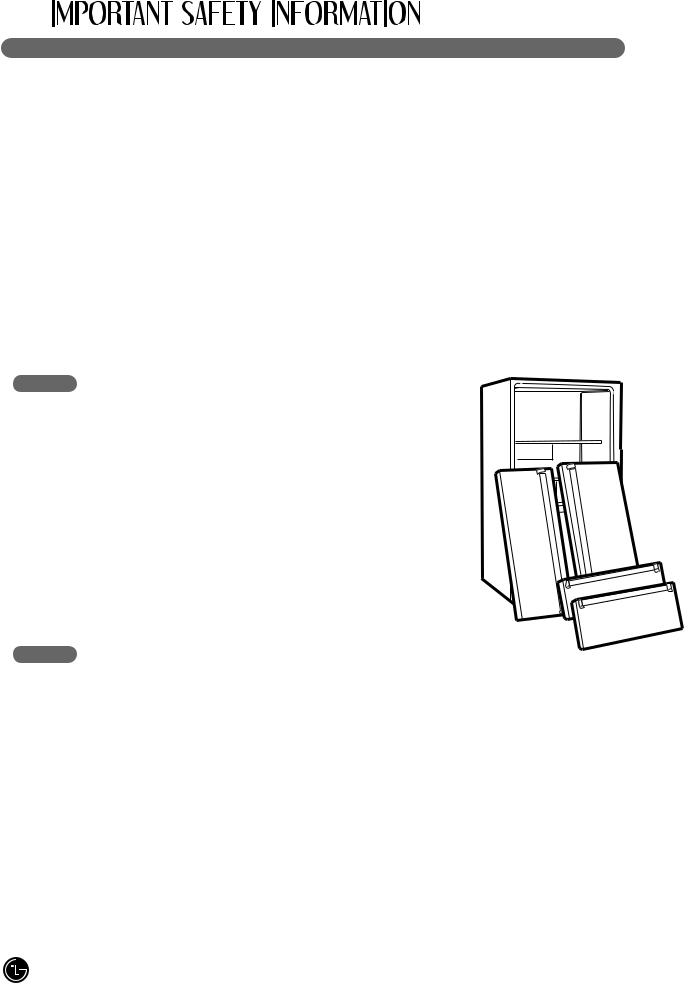
 BASIC SAFETY PRECAUTIONS (CONT.)
BASIC SAFETY PRECAUTIONS (CONT.)
•DO NOT refreeze frozen foods which have thawed completely. The United States Department of Agriculture in Home and Garden Bulletin No. 69 says:
…You may safely refreeze frozen foods that have thawed if they still contain ice crystals or if they are still cold—below 40°F (4°C).
…Thawed ground meats, poultry, or fish that have any off-odor or off-color should not be refrozen and should not be eaten. Thawed ice cream should be discarded. If the odor or color of any food is poor or questionable, dispose of it. The food may be dangerous to eat.
wDANGER
Risk of Child Entrapment
Discarded or abandoned refrigerators are dangerous, even if they will sit for just a few days. If you are disposing of your old refrigerator,
please follow the instructions below to help prevent accidents.
Before you throw away your old refrigerator or freezer:
•Take off the doors.
•Leave the shelves in place so that children may not easily climb inside.
CFC DISPOSAL
Your old refrigerator may have a cooling system that used CFCs (chlorofluorocarbons). CFCs are believed to harm stratospheric ozone.
If you are throwing away your old refrigerator, make sure the CFC refrigerant is removed for proper disposal by a qualified servicer. If you intentionally release this CFC refrigerant, you can be subject to fines and imprisonment under provisions of environmental legislation.
Even partial thawing and refreezing reduces the quality of foods, particularly fruits, vegetables, and prepared foods. The eating quality of red meats is affected less than that of many other foods. Use refrozen foods as soon as possible to save as much of their quality as you can.

 HOW TO CONNECT ELECTRICITY
HOW TO CONNECT ELECTRICITY
IMPORTANT: Please read carefully.
wWARNING
Electrical Shock Hazard
For personal safety, this appliance must be properly grounded. Have the wall outlet and the circuit checked by a qualified electrician to make sure the outlet is properly grounded.
RECOMMENDED GROUNDING METHOD
The refrigerator should always be plugged into its own individual properly grounded electrical outlet rated for 120 volts, 60 Hz, AC only, and fused at 20 amperes. This provides the
best performance and also prevents overloading house wiring circuits which could cause a fire hazard from overheated wires. It is recommended that a separate circuit serving only this appliance be provided.
Use a receptacle which cannot be turned off with a switch or pull chain. Do not use an extension cord. Where a standard two-prong wall outlet is encountered, it is your personal responsibility and obligation to have it replaced with a properly grounded three-prong wall outlet.
Do not, under any circumstances, cut or remove the third (ground) prong from the power cord.
Do not use an adapter plug.
NOTE: Some models have LED interior lighting and service should be performed by a qualified technician.
When you are finished, reconnect the refrigerator to the electrical source and reset the control (Thermostat, Refrigerator Control, or Freezer Control, depending on the model) to the desired setting.
USE OF EXTENSION CORDS
Because of potential safety hazards under certain conditions, we strongly recommend against the use of an extension cord.
However, if you still elect to use an extension
cord, it is absolutely necessary that it be a UL-listed (USA), 3-wire grounding-type appliance
extension cord having a grounding-type plug and outlet and that the electrical rating of the cord be 20 amperes (minimum) and 120 volts.
Use of an extension cord will increase the clearance needed for the back of the refrigerator.
SAVE THESE INSTRUCTIONS
5 
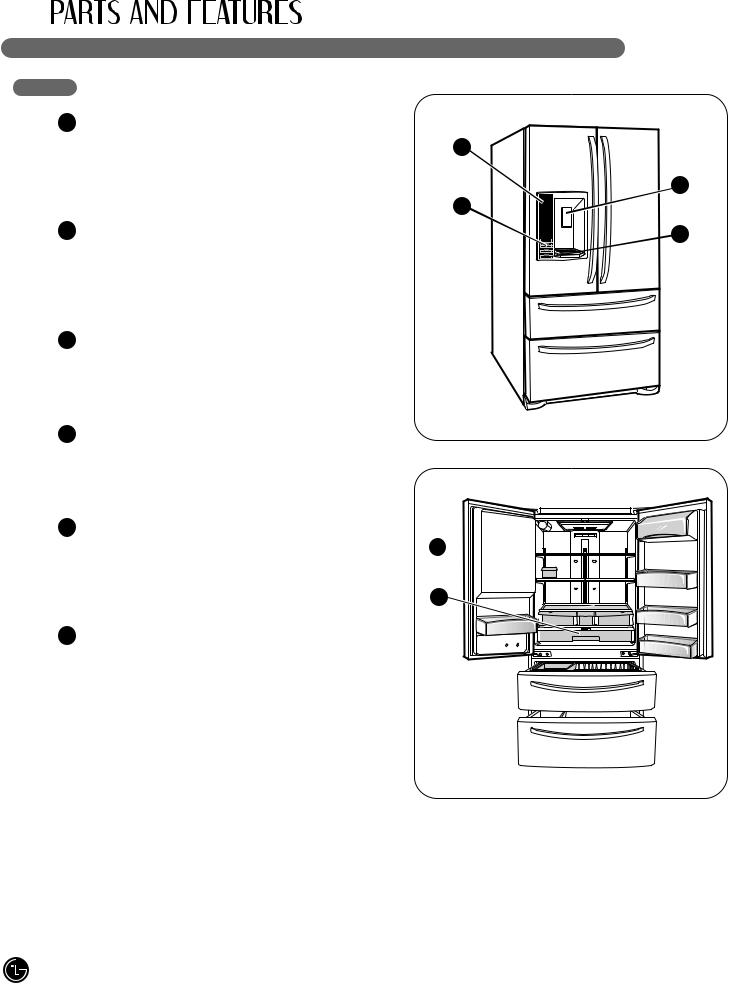
|
SPECIAL FEATURES |
1 |
DISPLAY SCREEN |
Simple electronic controls are user-friendly. The LED screen shows refrigerator and freezer temperatures, displays water filter status, dispenser information, and more.
2ICE PLUS
When this feature is activated, the freezer section will run at the coldest temperature for a 24hour period to increase ice production by about 20 percent.
3FILTERED WATER AND ICE DISPENSER
The water dispenser offers fresh, chilled, filtered water through the door. The ice dispenser offers cubed or crushed ice.
4DOOR ALARM
A warning alarm sounds at 30-second intervals when the refrigerator or freezer door is left open for more than 60 seconds.
5IN-DOOR ICE BIN
The icemaker automatically produces 80–130 ice cubes in a 24-hour period to keep the ice dispenser fully supplied. The in-door design creates more shelf space.
6CRISPERS
LG’s crispers preserve humidity and help vegetables stay crisp.
1
3
2

 4
4
5 
6
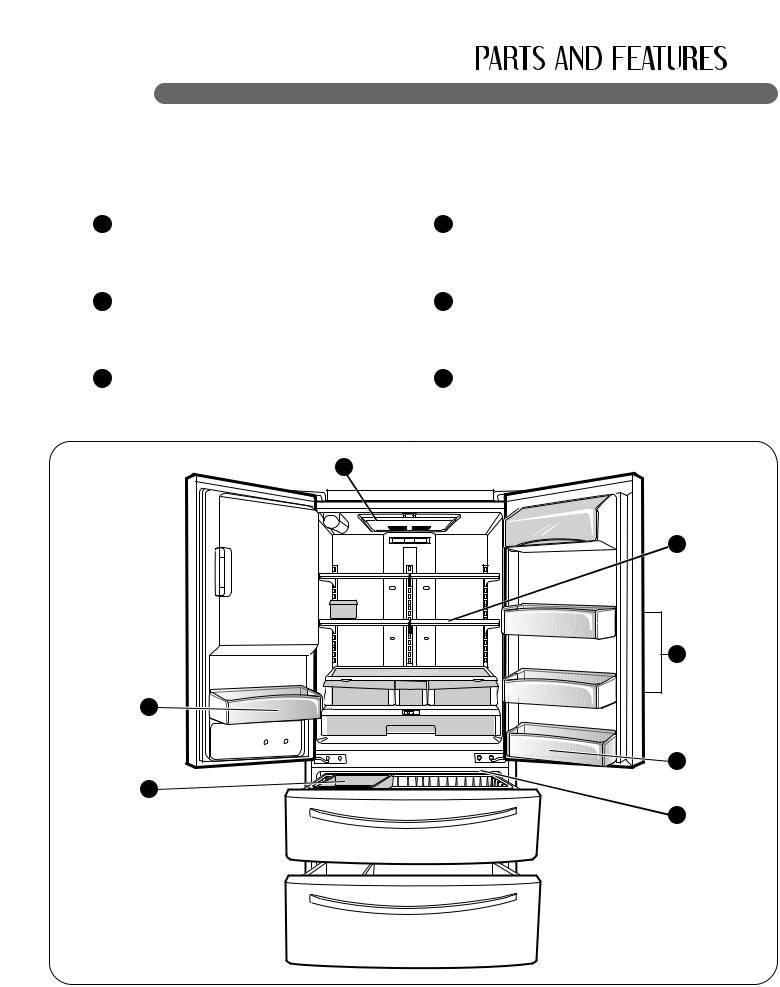
 KEY PARTS AND COMPONENTS
KEY PARTS AND COMPONENTS
In addition to the special features and components outlined in the Special Features section, there are several other important components that are referenced in this manual.
1 |
4 |
LAMPS |
The refrigerator compartment shelves are adjustable to allow flexibility for storage needs.
Two separate LED arrays light the freezer and refrigerator interiors.
2 MODULAR DOOR BINS |
5 |
TILTING DOOR BIN |
Three interchangeable bins can be arranged to |
|
|
suit your storage needs. |
|
|
3 |
6 |
FIXED DOOR BIN |
The ice storage bin can be removed to fill ice |
|
|
buckets, coolers, or pitchers. |
|
|
4 |
|
|
|
|
1 |
|
|
2 |
5 |
|
|
|
|
6 |
3 |
|
|
|
|
4 |
7 
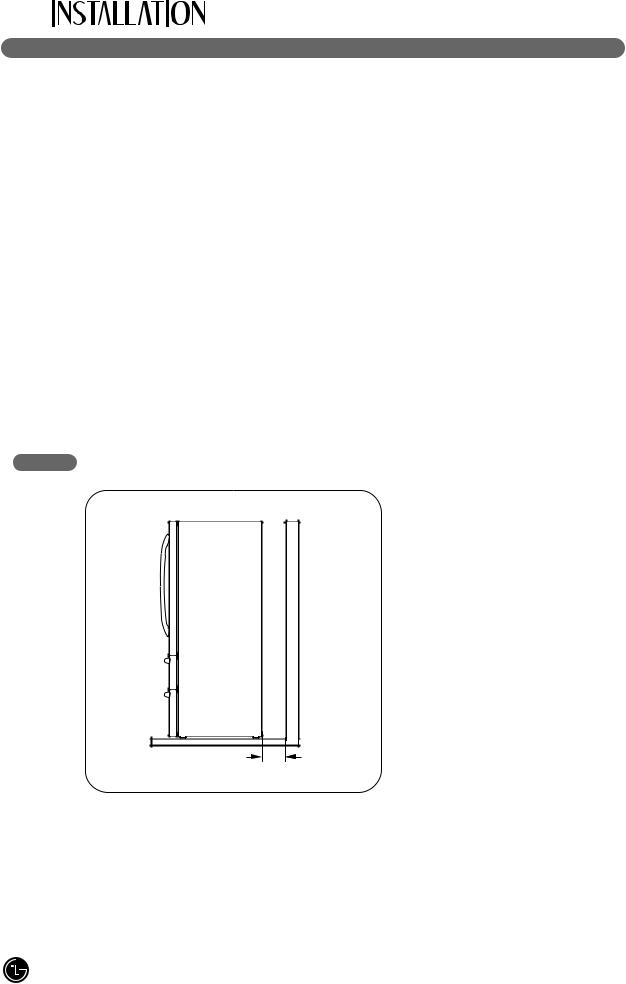
 CHOOSE THE PROPER LOCATION
CHOOSE THE PROPER LOCATION
wWARNING
Excessive Weight Hazard
Two or more people are required when moving and unpacking the appliance.
•Store and install the refrigerator where it will not be exposed to temperatures below freezing or exposed to outdoor weather conditions.
•Install this appliance in an area where the temperature is between 55°F (13°C) and 110°F (43°C). If the temperature around the appliance is too low or too high, cooling ability may be adversely affected.
•If this refrigerator is installed where the temperature is above 110°F (43°C), the freezing capacity is compromised and the cost of electricity used increases.
CLEARANCES
•To reduce the risk of electric shock, do not install the refrigerator in a wet or damp area.
•Select a place where a water supply can be easily connected for the automatic icemaker and dispenser.
•Unstable installation may cause vibration and noise. If the floor is not even, make the refrigerator level by rotating the height adjusting screws.
•Properly ground the refrigerator to conform with all governing codes and ordinances.
wCAUTION
Avoid placing the unit near heat sources, direct sunlight, or moisture.
•Too small a distance from adjacent items may result in lowered freezing capability and increased electricity consumption charges. Allow at least 24 in. (61 cm) in front of the refrigerator to open the doors.
NOTE: For complete dimensions and specifications, see page 41.
1" (2.54 cm)
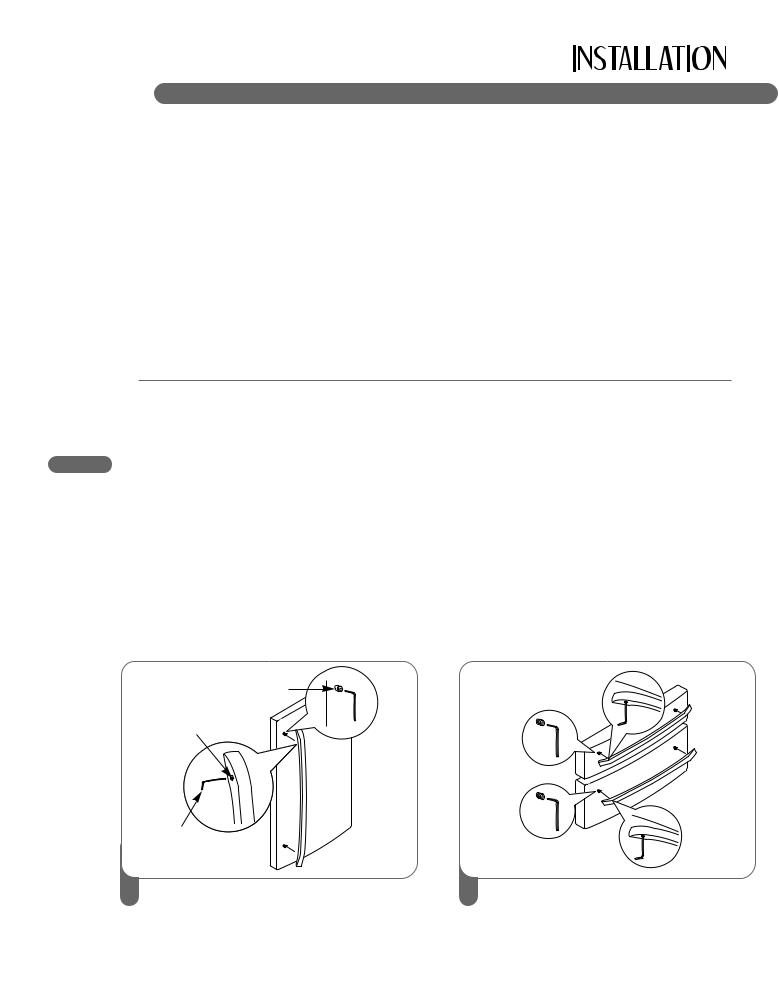
 FLOORING
FLOORING
•To minimize noise and vibration, the refrigerator MUST be installed on a solidly constructed floor.
•To avoid vibration, the unit must be level. If required, adjust the leveling legs to compensate for unevenness of the floor. The front should be slightly higher than the rear to aid in door closing. The leveling legs can be turned easily by pushing against the top of the refrigerator to take the weight off the feet. Turn the leveling legs clockwise to raise the unit or counterclockwise to lower it.
•Carpeting and soft tile surfaces are not recommended.
•Never install the refrigerator on a platform or weakly supported structure.
NOTE: When moving the refrigerator for cleaning or service, be sure to protect the floor. Always pull the refrigerator straight out when moving it.
Do not wiggle or walk the refrigerator when trying to move it; floor damage could occur.
NOTE: It is recommend that the doors be removed when it is necessary to move the refrigerator through a narrow opening.
HANDLE REMOVAL
To move the refrigerator through a house door, it may be necessary to remove the refrigerator door handles.
NOTE: Handle appearance may vary from illustrations on this page.
wCAUTION
•Use special care when removing handles to prevent scratching the doors.
•The handle could be damaged if you hit it with a hammer while removing or attaching.
•When you assemble or disassemble a handle, you must push or pull with reasonable force.
Mounting
Fasteners
Set Screw
Allen Wrench
1 |
2 |
9 
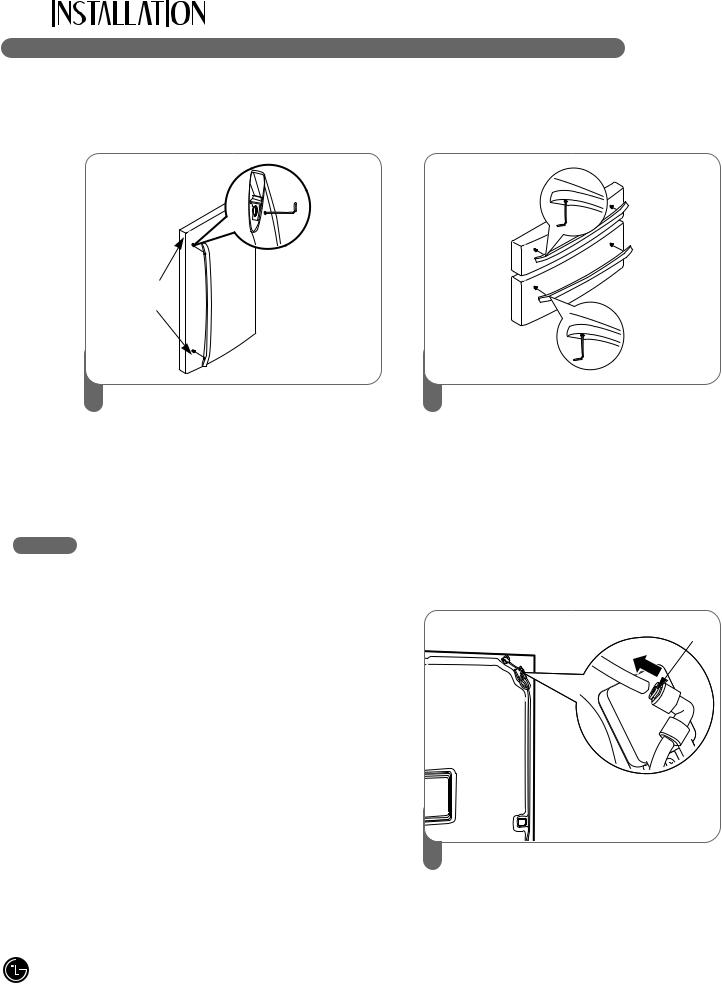
 HANDLE REMOVAL (CONT.)
HANDLE REMOVAL (CONT.)
HANDLE REINSTALLATION
Mounting
Fasteners
1 |
2 |
AND DRAWER REMOVAL
REMOVAL
WARNING
Collet
Shock Hazard
electrical supply to the refrigerator installing. Failure to do so could result in
or serious injury. |
|
|
not put hands or feet or metal sticks into the air |
|
|
base grille, or bottom of the refrigerator. You |
|
|
be injured or receive an electrical shock. |
|
|
careful when you work with the hinge, base |
|
|
and stopper. You may be injured. |
|
|
you begin, remove food and bins from the |
|
|
. |
|
|
entrance door is too narrow for the refrigerator |
1 |
|
through, remove the refrigerator door and |
||
|
||
the refrigerator sideways through the doorway. |
|

 DOOR AND DRAWER REMOVAL (CONT.)
DOOR AND DRAWER REMOVAL (CONT.)
DOOR REMOVAL (CONT.)
(2) |
(1) |
(2) |
|
|
|
|
(1) |
|
(3) |
(4) |
(5) |
|
(6) |
|
(5) |
(4) |
|
(6)
(3)
2 3
11 

 DOOR AND DRAWER REMOVAL (CONT.)
DOOR AND DRAWER REMOVAL (CONT.)
DOOR REINSTALLATION
(5)
(6)
(3)
(2)


 (1)
(1)
(4) 
1 |
2 |
(2) |
(4) |
|
(5) |
||
|
||
(1) |
|
|
|
(3) |
3 |
4 |
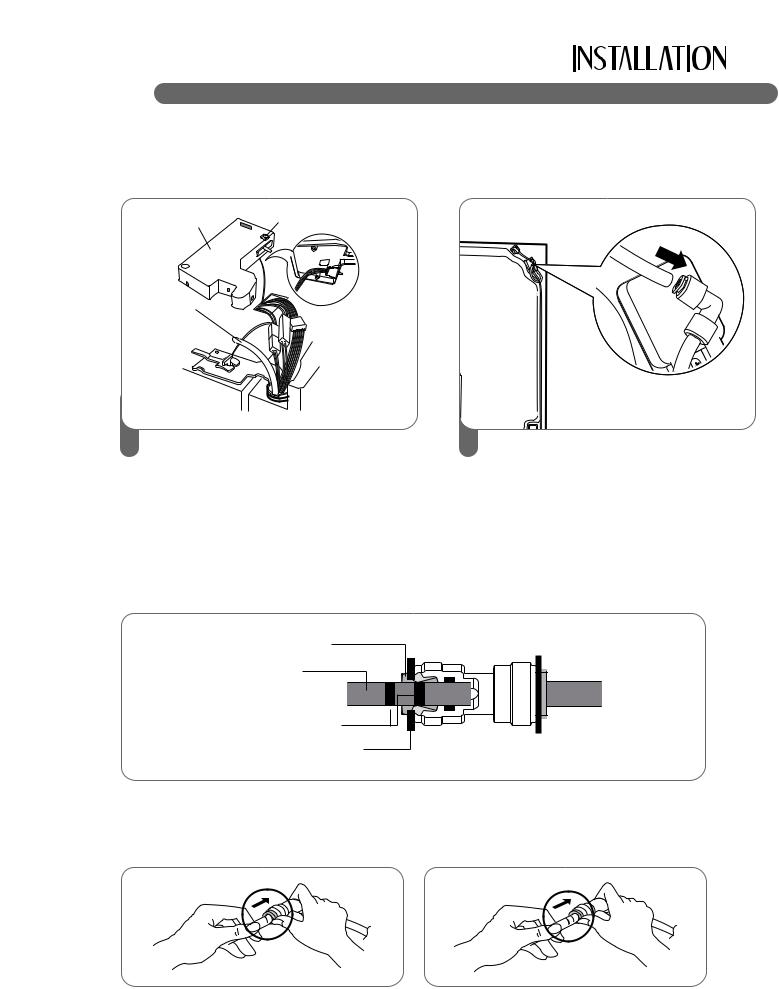
 DOOR AND DRAWER REMOVAL (CONT.)
DOOR AND DRAWER REMOVAL (CONT.)
DOOR REINSTALLATION (CONT.)
Cover |
Cover Screw |
|
(6)
5 |
6 |
wCAUTION
Collet
Tube
Insert Line
Clip
Correct |
Incorrect |
13 
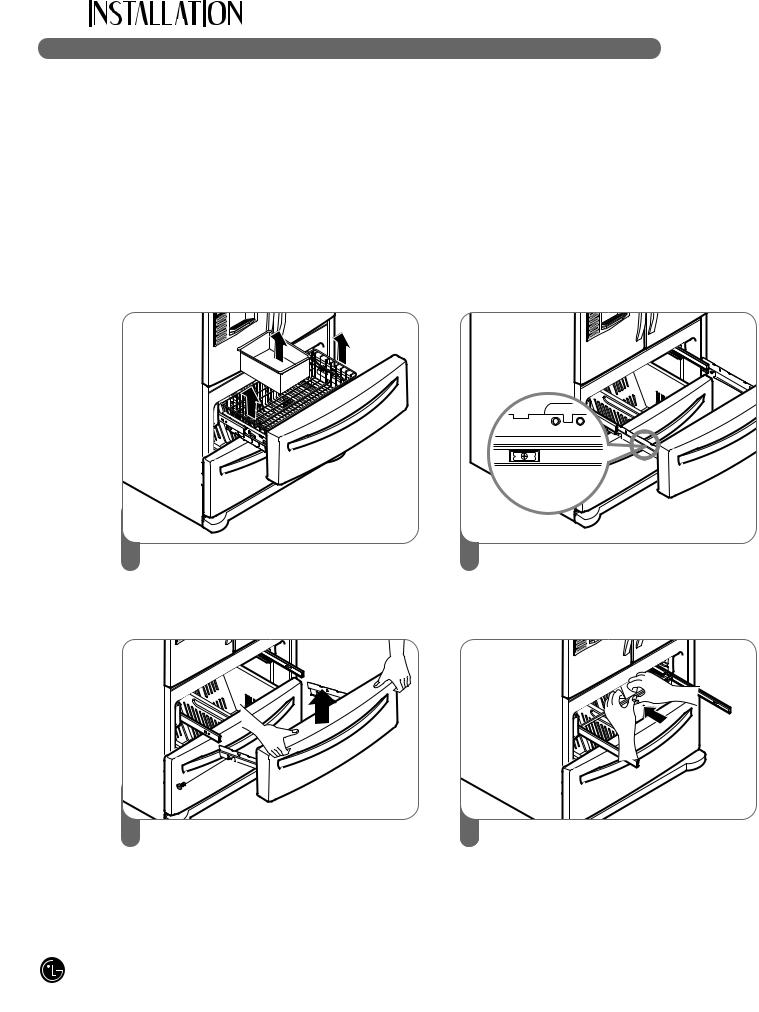
 DOOR AND DRAWER REMOVAL (CONT.)
DOOR AND DRAWER REMOVAL (CONT.)
FREEZER DRAWER REMOVAL
wCAUTION
•To avoid possible injury or product or property damage, you will need two people to perform the following instructions.
•When you remove the drawer, do not hold the handle. It may come off and could cause injury.
•When laying the drawer down, be careful not to damage the floor or hurt your feet with the sharp edges on the hinge side.
TOP DRAWER
1
3
|
to allow the gears on both ends to release |
|
from the track. |
wCAUTION: When you remove the drawer, do not hold |
handle. If it may come off and it could cause |
personal injury. |
|
wCAUTION: When laying the drawer down, be careful |
damage the floor or hurt your feet by the |
sharp edges on hinge side. |
|
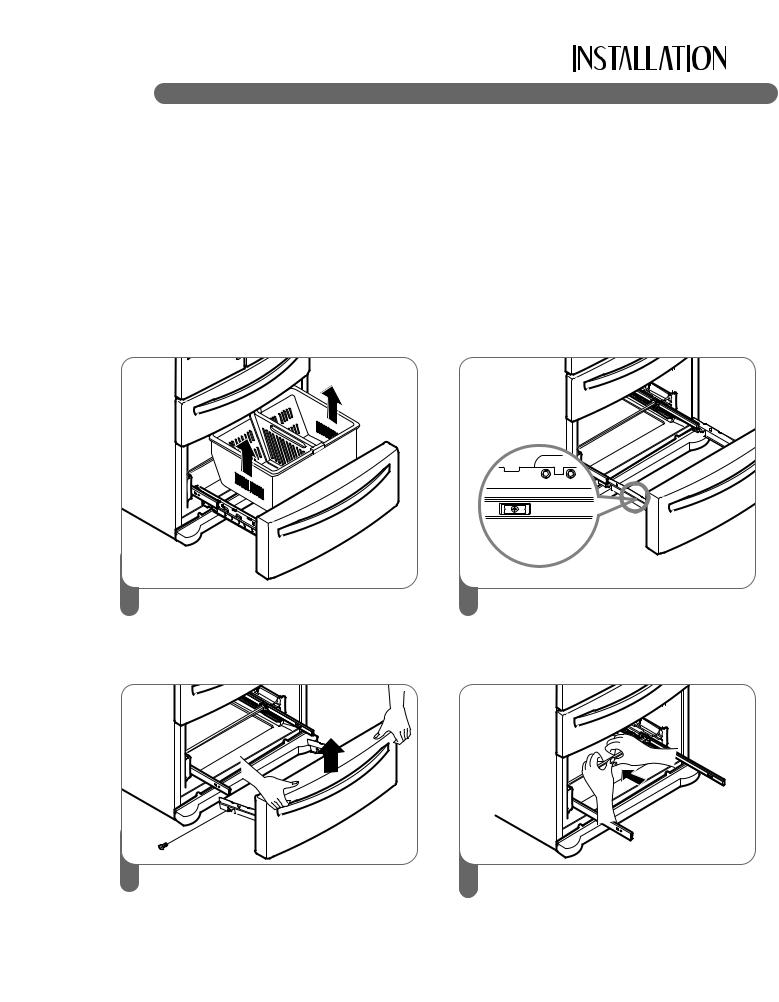
 DOOR AND DRAWER REMOVAL (CONT.)
DOOR AND DRAWER REMOVAL (CONT.)
FREEZER DRAWER REMOVAL
wCAUTION
•To avoid possible injury or product or property damage, you will need two people to perform the following instructions.
•When you remove the drawer, do not hold the handle. It may come off and could cause injury.
•When laying the drawer down, be careful not to damage the floor or hurt your feet with the sharp edges on the hinge side.
BOTTOM DRAWER
1
3
|
to allow the gears on both ends to release |
|
from the track. |
wCAUTION: When you remove the drawer, do not hold |
handle. If it may come off and it could cause |
personal injury. |
|
wCAUTION: When laying the drawer down, be careful |
damage the floor or hurt your feet by the |
sharp edges on hinge side. |
|
15 
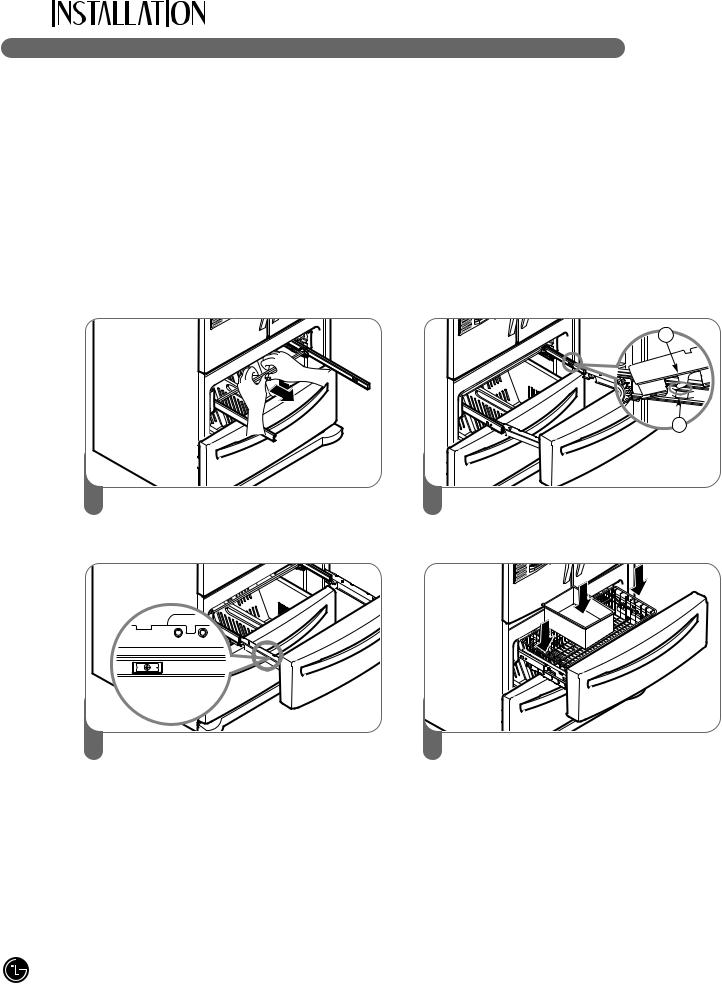
 DOOR AND DRAWER REMOVAL (CONT.)
DOOR AND DRAWER REMOVAL (CONT.)
FREEZER DRAWER REINSTALLATION
wCAUTION
•To avoid possible injury or product or property damage, you will need two people to perform the following instructions.
TOP DRAWER
1
wDANGER
Risk of Child Entrapment
•To prevent accidental child and pet entrapment or suffocation risk, DO NOT allow them to play inside of the freezer drawer.
•DO NOT step or sit on the freezer drawer.
1
2
2
3 |
4 |
wWARNING: To prevent accidental child and pet entrapment or suffocation risk. DO NOT allow them to play inside of drawer.
wWARNING: DO NOT step or sit down on freezer.
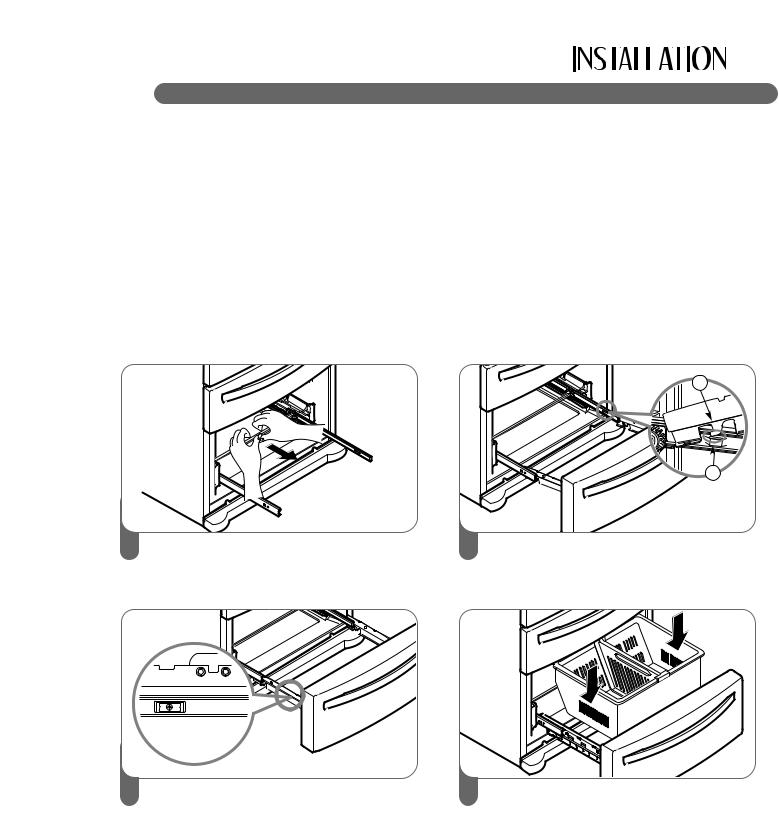
 DOOR AND DRAWER REMOVAL (CONT.)
DOOR AND DRAWER REMOVAL (CONT.)
FREEZER DRAWER REINSTALLATION
wCAUTION
•To avoid possible injury or product or property damage, you will need two people to perform the following instructions.
BOTTOM DRAWER
1
wDANGER
Risk of Child Entrapment
•To prevent accidental child and pet entrapment or suffocation risk, DO NOT allow them to play inside of the freezer drawer.
•DO NOT step or sit on the freezer drawer.
1
2
2
3 |
4 |
wWARNING: To prevent accidental child and pet entrapment or suffocation risk. DO NOT allow them to play inside of drawer.
wWARNING: DO NOT step or sit down on freezer.
17 
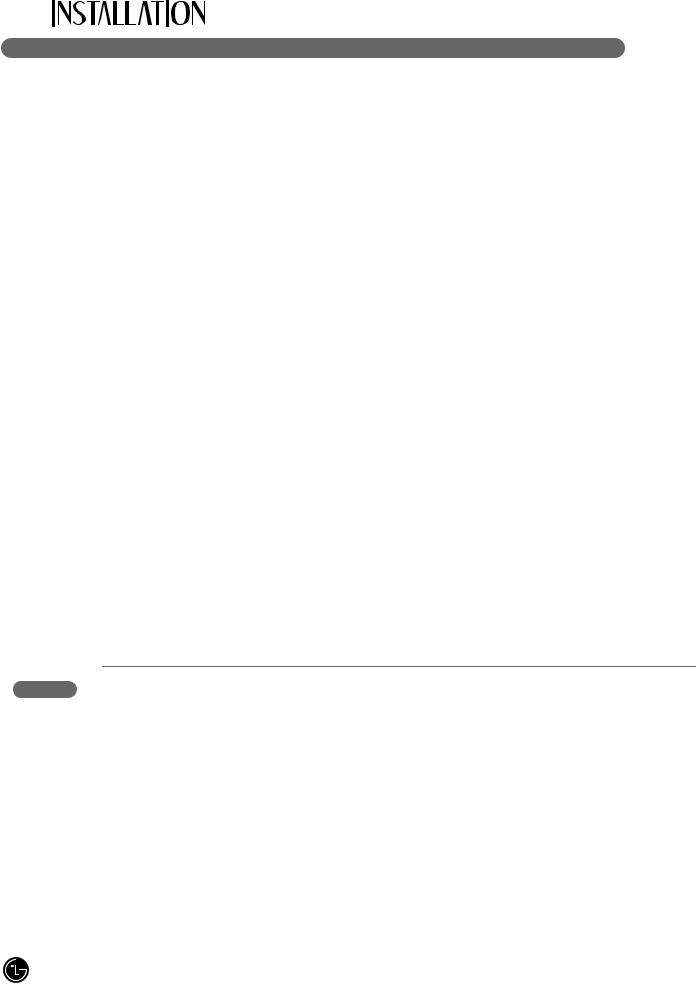
 CONNECTING THE WATER SUPPLY
CONNECTING THE WATER SUPPLY
wWARNING
Connect to safe drinking water supply only.
•The water pressure must be between 21 and 121 p.s.i. (1.5~8.5 kgf/cm2 ) on models without a water filter and between 43 and 121 p.s.i. (3~8.5 kgf/cm2) on models with a water filter.
•If water pressure does not reach 21 psi (1.5kgf/cm2) or falls below, it is necessary to purchase a separate pressure pump for normal automatic icemaker and water dispensing operation.
•It is recommended that the total length of the water feed tube does not exceed 26 ft. (8 m).
•Install the water supply line where it will not be affected by heat.
IMPORTANT: Read all directions thoroughly before you begin.
•If operating the refrigerator before installing the water connection, turn the icemaker to the OFF position to prevent operation without water.
•All installations must be in accordance with local plumbing code requirements.
•Use copper tubing and check for leaks.
•Install tubing only in areas where temperatures will remain above freezing.
•It may take up to 24 hours for the icemaker to begin producing ice.
Tools Required
•Standard screwdriver
•7/16-in. and 1/2-in. open-end wrenches or two adjustable wrenches
•1/4-in. nut driver
•1/4-in. drill bit
•Hand drill or electric drill (properly grounded)
NOTE: Refrigerator dealers offer a kit with a 1/4-in. saddle-type shutoff valve, a union, and copper tubing. Before purchasing, make sure a saddletype valve complies with local plumbing codes.
Do not use a piercing-type or 3/16-in. saddle valve which reduces water flow and clogs more easily.
NOTE: The Commonwealth of Massachusetts Plumbing Code 248CMR shall be adhered to.
Saddle valves are illegal and use is not permitted in Massachusetts. Consult with your licensed plumber.
Cold Water Supply
•The icemaker water valve contains a flow washer which is used as a water pressure regulator.
•The icemaker needs to be connected to a cold water line with water pressure between 21~121 psi (1.5~8.5 kgf/cm2) on models without a water filter and between 43 and 121 p.s.i. (3~8.5kgf/cm2) on models with a water filter.
CONNECTING THE WATER LINES
IMPORTANT: Before connecting the tubing to the water line, unplug the refrigerator or disconnect the power.
•Turn off the main water supply and open the nearest faucet to relieve pressure in the line. Opening an outside faucet may help drain water from the line in the house.
•Find a 1/2-in. vertical COLD water pipe near the refrigerator.
NOTE: A horizontal pipe will work, but the following precaution must be taken: drill on the top of the pipe, not the bottom. This will help keep water away from the drill and also keep normal sediment from collecting in the valve.
•To determine the length of copper tubing you will need, measure from the connection on the lower left rear of the refrigerator to the water pipe. Add 7 ft. (2.1 m) to allow for moving the refrigerator for cleaning. Use 1/4-in. O.D. (outside diameter) copper tubing. Be sure both ends of the copper tubing are cut square.
•Using a drill, drill a 1/4-in. hole in the cold water pipe you have selected.
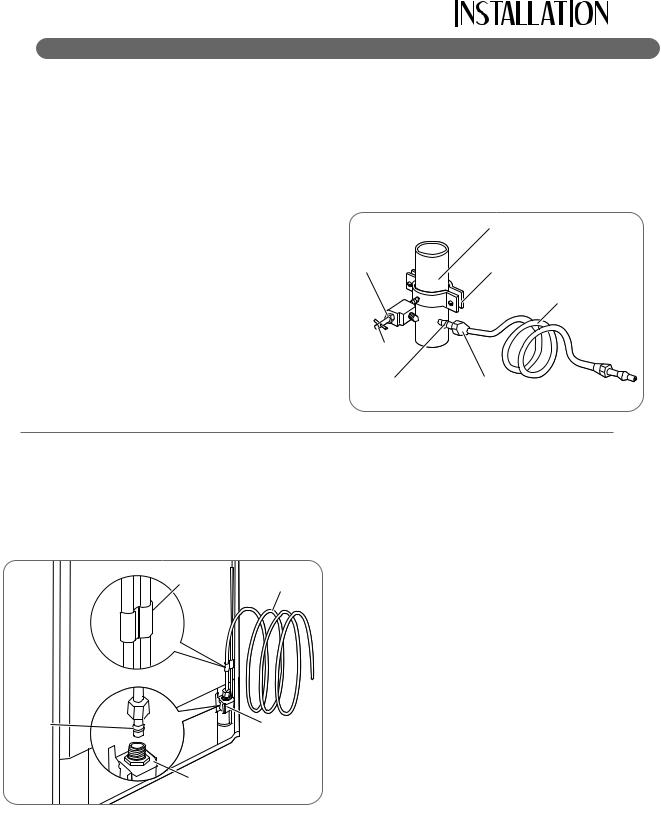
 CONNECTING THE WATER LINES (CONT.)
CONNECTING THE WATER LINES (CONT.)
•Fasten with solidly pipe Tighten
screws carefully and evenly so the washer makes a watertight seal. Do not overtighten or you may crush the copper tubing, especially if soft (coiled) copper tubing is used. Now you are ready to connect the copper tubing.
•Slip the compression sleeve and the compression nut onto the copper tubing as shown. Insert the end of the tubing into the outlet end squarely as far as it will go. Screw the compression nut onto the outlet end with a wrench. A flare nut wrench works best, but an open-end wrench will suffice. Do not overtighten.
|
Cold Water Pipe |
Packing |
Pipe Clamp |
Nut |
Coil of Polyethelyne or Copper Tubing
Shutoff
Valve
Compression |
Compression |
Sleeve |
Nut |
IMPORTANT: Before connecting the tubing to the refrigerator, be sure the refrigerator power cord is
•Insert the end of the copper tubing into the connection as far as possible. While holding the tubing, tighten the fitting.
with an |
IMPORTANT: Tighten any connections that leak. |
water filter |
Open the water at the shutoff valve. |
|
• Plug in the refrigerator. |
Tubing |
1/4" |
Tubing |
|
Clamp |
|
1/4"
Compression Nut 
Ferrule |
Water |
(Sleeve) |
valve |
|
Refrigerator
Connection
•Remove the plastic flexible cap from the water valve.
•Place the compression nut and ferrule (sleeve) onto the end of the tubing as shown.
•Arrange the coil of copper tubing behind the refrigerator so it does not vibrate against the back of the refrigerator or against the wall.
•Check for leaks.
•Before connecting the water line to house, purge house line for 2 minute.
NOTE: It may take a few seconds for water to begin to flow as the internal tank fills and air clears from the lines.
•Push the refrigerator back to the wall.
•Set the icemaker switch to the ON position.
NOTE: The icemaker will not begin to operate until it reaches its operating temperature of 15°F (-9°C). It will then begin operation automatically.
NOTE: Throw away the first few batches of ice (about 20 pieces).
19 
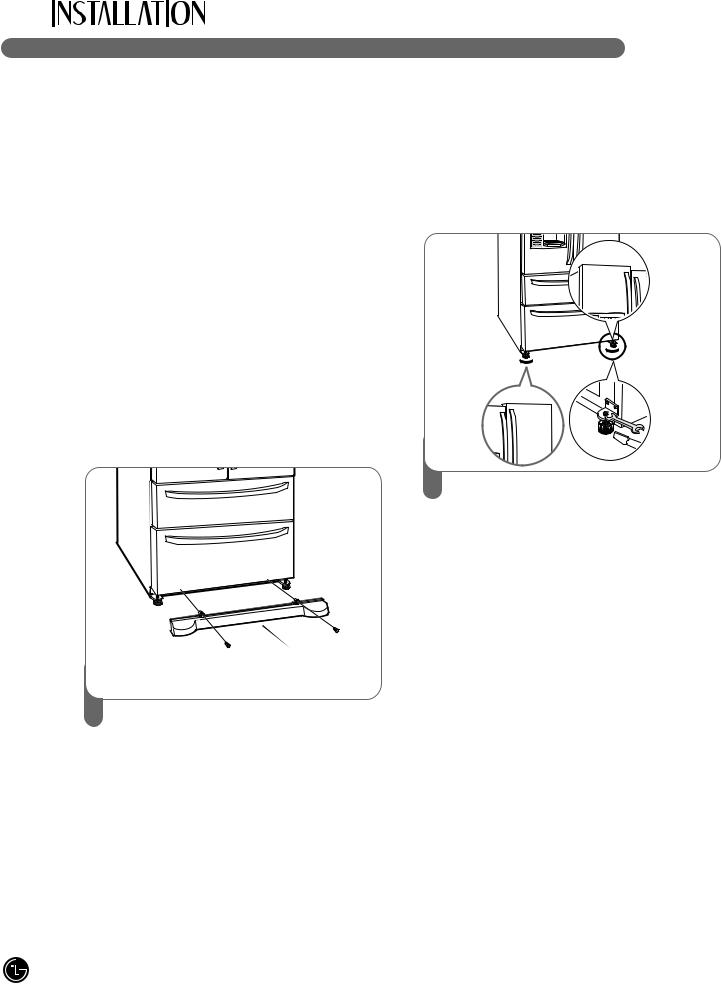
 LEVELING THE REFRIGERATOR DOORS
LEVELING THE REFRIGERATOR DOORS
wWARNING
Electrical Shock Hazard
• Be careful when you work with the hinges, grille, and stopper. You may be injured.
not put hands, feet, or metal items into air vents, base grille, or the bottom of the
. You may be injured or receive electrical shock.
installing, secure the product with the LEG to move left or right.
refrigerator has two front leveling legs— on the right and one on the left. Adjust the to alter the tilt from front to back or side to
.If your refrigerator seems unsteady or you the doors to close more easily, adjust the
wCAUTION
•To avoid possible injury or product or property damage, you will need two people to perform the following instructions.
2
Kick Plate
1
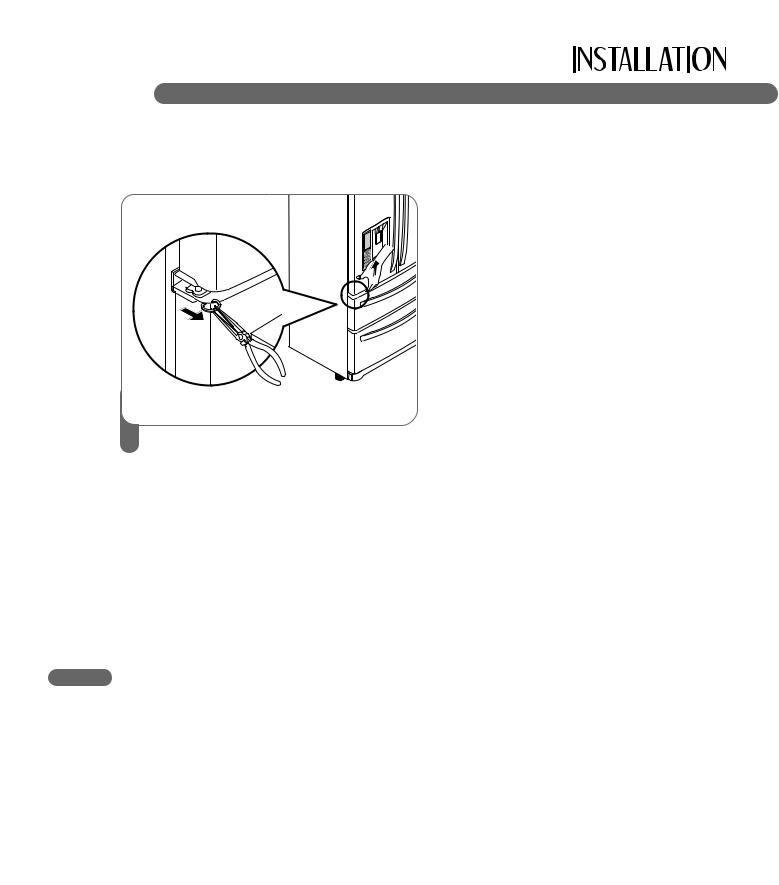
 LEVELING THE REFRIGERATOR DOORS (CONT.)
LEVELING THE REFRIGERATOR DOORS (CONT.)
DOOR ALIGNMENT
1
loading your refrigerator with fresh foods:
tape and any temporary labels from refrigerator before using. To remove any
adhesive residue, rub the area briskly your thumb, or rub a small amount of liquid soap over the adhesive with your fingers. with warm water and dry. Do not use sharp
rubbing alcohol, flammable fluids, abrasive cleaners to remove tape or glue.
Do not remove any warning-type labels, model and serial number label, or the tech
sheet that is taped to the back of the refrigerator.
•Thoroughly clean your refrigerator and wipe off all dust that may have accumulated during shipping.
•Install accessories such as the ice cube bin, drawers, and shelves, in their proper places. They are packed together to prevent possible damage during shipment.
•Adjust the desired temperature for the refrigerator and freezer (see Adjusting the Temperature and Functions).
•Let your refrigerator run for at least 2 or 3 hours before putting food in it. Check the flow of cold air in the freezer compartment to ensure proper cooling. Your refrigerator is now ready for use.
21 
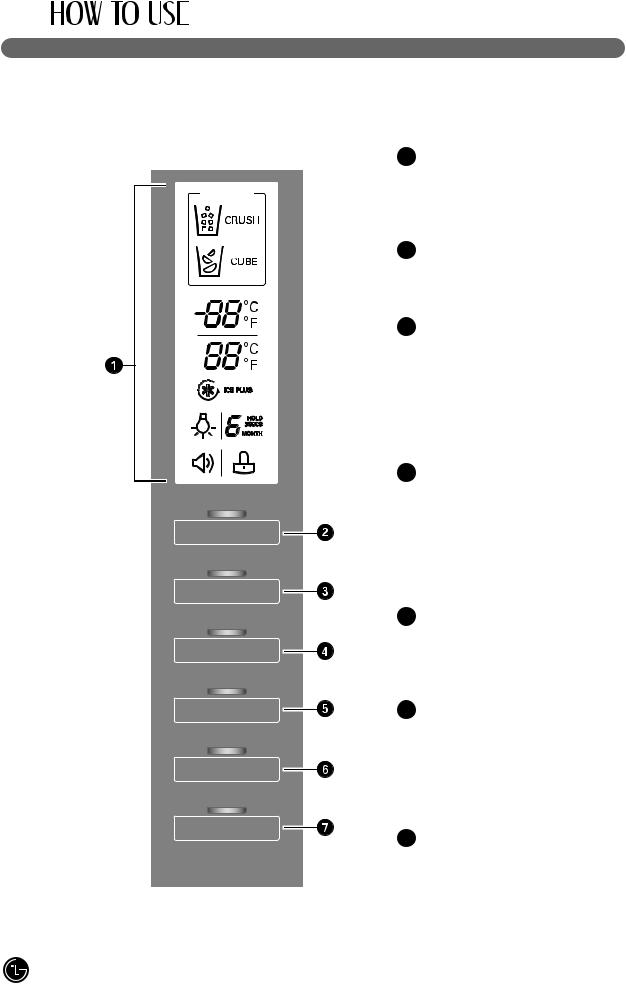
 CONTROL PANEL FEATURES
CONTROL PANEL FEATURES
For complete details on button functions, see pages 24–26.
ICE TYPE
ICE TYPE
FREEZER
REFRIGERATOR
ICE PLUS
LIGHT / FILTER
ALARM / LOCK3SECS
1LED DISPLAY
The LED display shows the temperature settings, dispenser options, water filter, door alarm, and locking status messages.
The ICE TYPE button is used to select Cubed Ice or Crushed Ice.
3FREEZER BUTTON
Press the FREEZER button to adjust the temperature in the freezer compartment.
NOTE: When pressed simultaneously with the REFRIGERATOR button for more than five seconds, the temperature display will change from Fahrenheit to Celsius or vice versa.
4REFRIGERATOR BUTTON
Press the REFRIGERATOR button to adjust the temperature in the refrigerator compartment.
NOTE: When pressed simultaneously with the FREEZER button for more than five seconds, the temperature display will change from Fahrenheit to Celsius or vice versa.
5ICE PLUS BUTTON
Press this button to turn on the ICE PLUS. feature, which increases icemaking capabilities up to about 20 percent.
6LIGHT/FILTER BUTTON
The LIGHT/FILTER button controls the lamp in the dispenser.
The LIGHT/FILTER button resets the water filter replacement indicator when the water filter has been replaced.
7ALARM/LOCK BUTTON
Press this button to control the door-open alarm.
Press this button to lock or unlock all the other function buttons on the control panel, including operation of the dispenser.
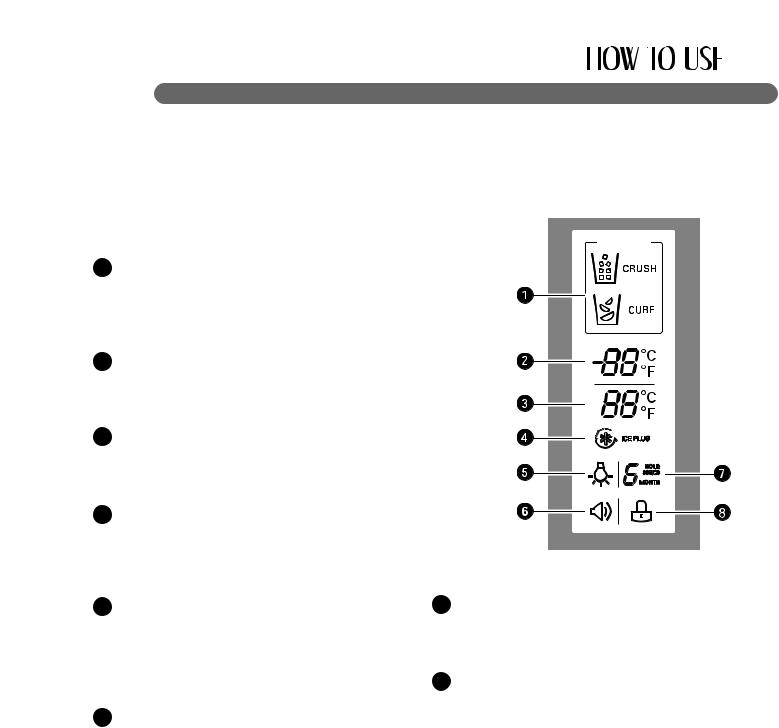
 THE LED DISPLAY
THE LED DISPLAY
The LED display shows the temperature settings, dispenser options, water filter, door alarm, and locking status messages.
1DISPENSER SELECTION INDICATOR
Shows Cubed ice or Crushed Ice selection that will be dispensed when the push switch is pressed.
Indicates the set temperature of the freezer compartment in Celsius or Fahrenheit.
3REFRIGERATOR TEMPERATURE
Indicates the set temperature of the refrigerator compartment in Celsius or Fahrenheit.
4ICE PLUS
When the ICE PLUS button is pressed,
the display will indicate the selected function has been activated.
5
When the LIGHT button is pressed,
the display will indicate the selected function: The dispenser light is on, this indicator will appear on the display panel.
6DOOR ALARM INDICATOR
This indicator shows that the door-open warning alarm is activated.
ICE TYPE
7WATER FILTER STATUS
This indicator shows the current status for
the water filter. See Resetting the Filter Indicator.
8LOCK STATUS
This indicator shows the current status for the control panel functions is set to LOCK.
23 

 ADJUSTING THE TEMPERATURES AND DISPLAY
ADJUSTING THE TEMPERATURES AND DISPLAY
Adjust Freezer Temperature
To adjust the temperature in the freezer  compartment, press the FREEZER button to cycle FREEZER through the the range of available settings.
compartment, press the FREEZER button to cycle FREEZER through the the range of available settings.
REFRIGERATOR
FREEZER
Adjust Refrigerator Temperature
To adjust the temperature in the refrigerator compartment, press the REFRIGERATOR button to cycle through the range of available settings.
REFRIGERATOR
NOTE: The actual inner temperature varies depending on the food status, since the indicated temperature setting is the target temperature and not the actual temperature within the refrigerator.
Initially set the REFRIGERATOR CONTROL at 37 degrees F and the FREEZER CONTROL at 0 degrees F. Leave them at these setting for 24 hours (one day) to stabilize. Then adjust the compartment temperature as illustrated above.
Temperature Display
To change the temperature display from Fahrenheit to Celsius:
•Simultaneously press and hold the FREEZER and REFRIGERATOR buttons for more than 5 seconds.
•Do the same to convert back to Fahrenheit.
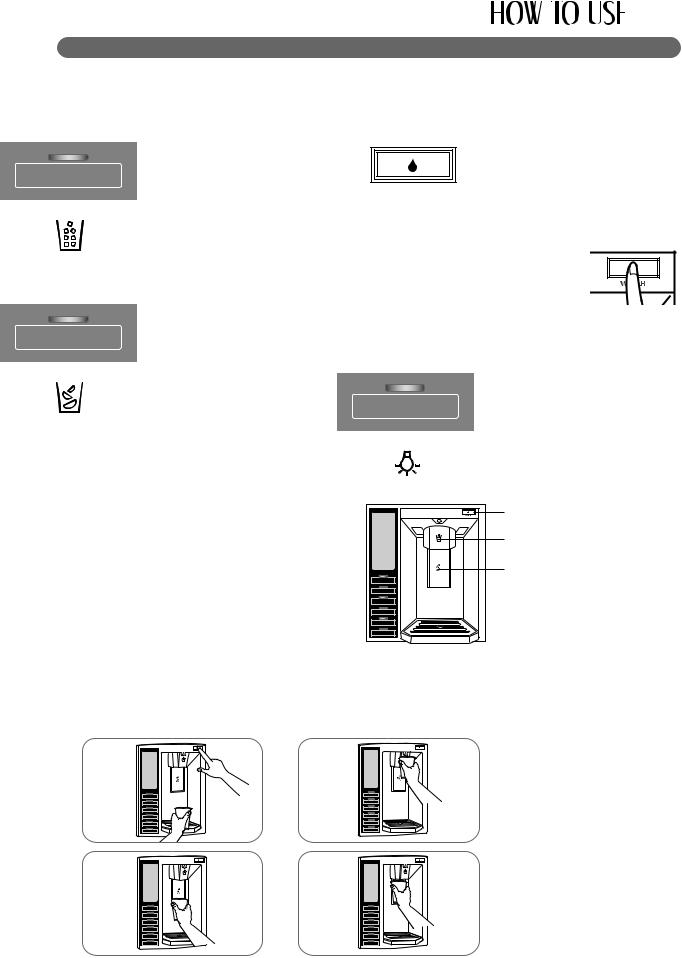
 OPERATING THE DISPENSER
OPERATING THE DISPENSER
ICE TYPE
ICE TYPE
NOTE: Hold the glass or other container in place for a couple of seconds after dispensing ice or water to catch the last few cubes or drops. The dispenser is designed to not operate while either refrigerator door is open.
wCAUTION
LIGHT / FILTER
ACTIVE WATER BUTTON |
WATER SWITCH |
ICE SWITCH |
When filling the container with a small opening, use it near the opening of the water or ice dispenser as close as possible.
Incorrect |
Correct |
Water
Ice
25 
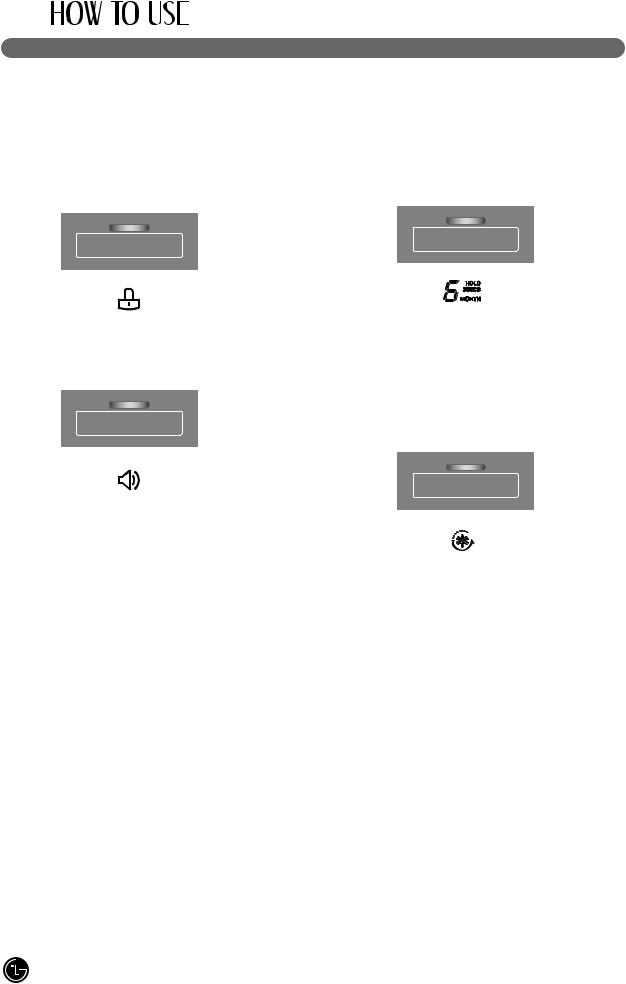
 SETTING THE FUNCTIONS
SETTING THE FUNCTIONS
Press the button for the desired function to view and select other settings.
LIGHT / FILTER
ALARM / LOCK3SECS
ALARM / LOCK3SECS
ICE PLUS
INDICATOR
the
button for more to reset
after the been
replace the filter reaches 0 or
taste deteriorates
PLUS button the ICE PLUS
ICE PLUS icon on panel will illuminate
.
function runs the compartment at the
for a 24-hour increase icemaking by
20%, and then turns
.
cancel
DIAGNOSTIC FAILURE DETECTION
The diagnostic function automatically detects problems with your refrigerator, and a diagnostic code will appear in the display. NOTE: If a diagnostic code appears in the display during use, note the code and then call 1-800-243-0000 (24 hours per day/7 days per week) and select the option to locate an authorized servicer.
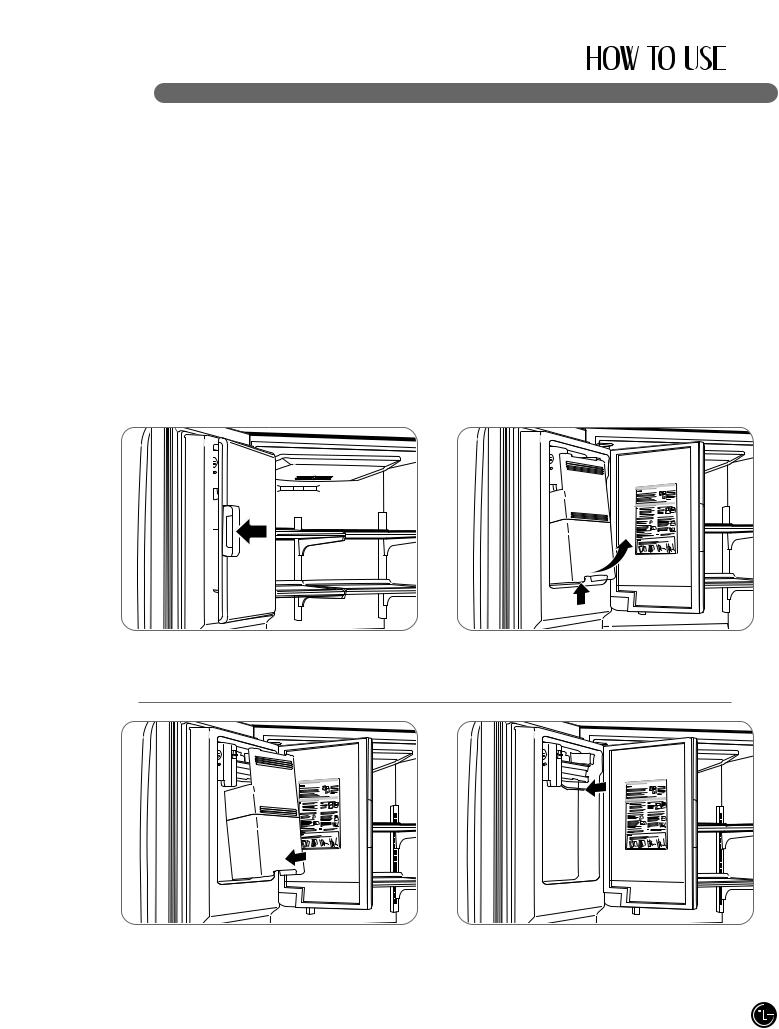
 IN-DOOR ICE BIN
IN-DOOR ICE BIN
wCAUTION
• Keep hands and tools out of the ice bin door |
NOTE: Storing cans or other items in the ice bin may |
|||||||||||||||||||||||||
and dispenser chute. You could break |
damage the icemaker. |
|||||||||||||||||||||||||
something or injure yourself. |
Keep the ice bin door closed tightly. If the ice bin door |
|||||||||||||||||||||||||
The icemaker will stop producing ice when the ice bin |
is not closed tightly, the cold air in the ice bin will |
|||||||||||||||||||||||||
freeze food in the refrigerator compartment. This |
||||||||||||||||||||||||||
is full. If you need more ice, empty the ice bin into the |
||||||||||||||||||||||||||
could also cause the icemaker to not produce ice. |
||||||||||||||||||||||||||
extra ice bin in the freezer compartment so the |
||||||||||||||||||||||||||
NOTE: If the On/Off switch on the icemaker is set to |
||||||||||||||||||||||||||
icemaker can keep producing ice. |
||||||||||||||||||||||||||
Shake the ice bin occasionally to level the ice in it. |
Off for an extended time, the ice compartment will |
|||||||||||||||||||||||||
gradually warm up to the temperature of the |
||||||||||||||||||||||||||
Sometimes the ice piles up near the icemaker, |
||||||||||||||||||||||||||
refrigerator compartment. To prevent ice cubes from |
||||||||||||||||||||||||||
causing the icemaker to misread the amount of ice |
||||||||||||||||||||||||||
melting and leaking from the dispenser, ALWAYS |
||||||||||||||||||||||||||
cubes and stop producing ice. |
||||||||||||||||||||||||||
empty the ice bin when the icemaker is set to Off for |
||||||||||||||||||||||||||
|
|
|
|
|
|
|
|
|
|
|
|
|
|
|||||||||||||
|
|
|
|
|
|
|
|
|
|
|
|
|
|
more than a few. |
||||||||||||
|
|
|
|
|
|
|
|
|
|
|
|
|
|
|
|
|
|
|
|
|
|
|
|
|
|
|
|
|
|
|
|
|
|
|
|
|
|
|
|
|
|
|
|
|
|
|
|
|
|
|
|
|
|
|
|
|
|
|
|
|
|
|
|
|
|
|
|
|
|
|
|
|
|
|
|
|
|
|
|
|
|
|
|
|
|
|
|
|
|
|
|
|
|
|
|
|
|
|
|
|
|
|
|
|
|
|
|
|
|
|
|
|
|
|
|
|
|
|
|
|
|
|
|
|
|
|
|
|
|
|
|
|
|
|
|
|
|
|
|
|
|
|
|
|
|
|
|
|
|
|
|
|
|
|
|
|
|
|
|
|
|
|
|
|
|
|
|
|
|
|
|
|
|
|
|
|
|
|
|
|
|
|
|
|
|
|
|
|
|
|
|
|
|
|
|
|
|
|
|
|
|
|
|
|
|
|
|
|
|
|
|
|
|
|
|
|
|
|
|
|
|
|
|
|
|
|
|
|
|
|
|
|
|
|
|
|
|
|
|
|
|
|
|
|
|
|
|
|
|
|
|
|
|
|
|
|
|
|
|
|
|
|
|
|
|
|
|
|
|
|
|
|
|
|
|
|
|
|
|
|
|
|
|
|
|
|
|
|
|
|
|
|
|
|
|
|
|
|
|
|
|
|
|
|
|
|
|
|
|
|
|
|
|
|
|
|
|
|
|
|
|
|
|
|
|
|
|
|
|
|
|
|
|
|
|
|
|
|
|
|
|
|
|
|
|
|
|
|
|
|
|
|
|
|
|
|
|
|
|
|
|
|
|
|
|
|
|
|
|
|
|
|
|
|
|
|
|
|
|
|
|
|
|
|
|
|
|
|
|
|
|
|
|
|
|
|
|
|
|
|
|
|
|
|
|
|
|
|
|
|
|
|
|
|
|
|
|
|
|
|
|
|
|
|
|
|
|
|
|
|
|
|
|
|
|
|
|
|
|
|
|
|
|
|
|
|
|
|
|
|
|
|
|
|
|
|
|
|
|
|
|
|
|
|
|
|
|
|
|
|
|
|
|
|
|
|
|
|
|
|
|
|
|
|
|
|
|
|
|
|
|
|
|
|
|
|
|
|
|
|
|
|
|
|
|
|
|
|
|
|
|
|
Automatic |
shutoff Arm |
27 |
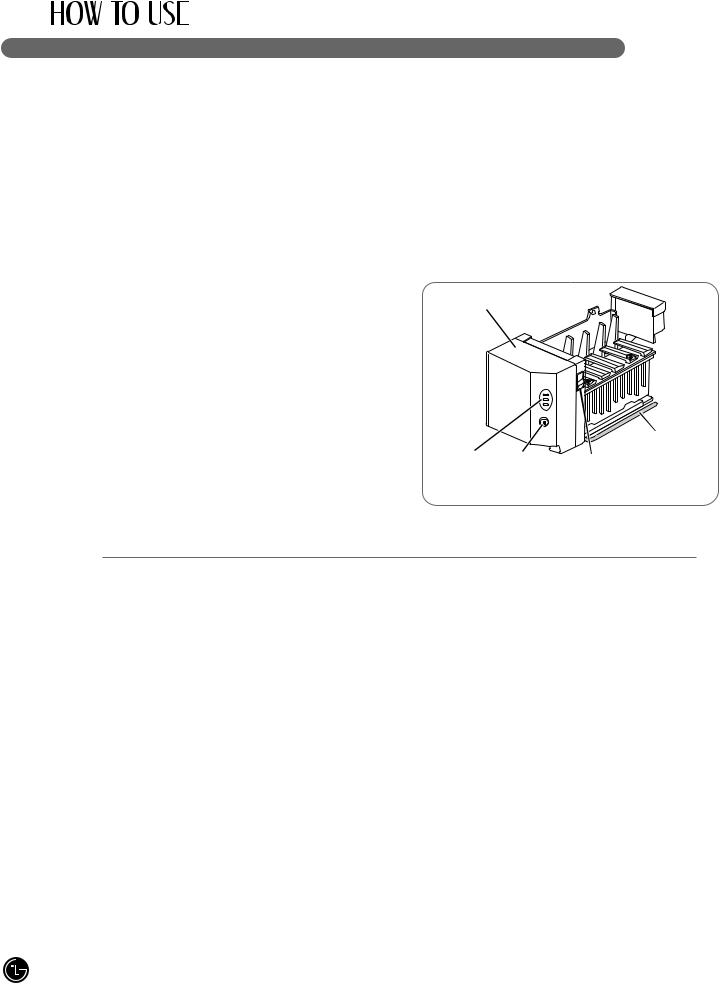
 AUTOMATIC ICEMAKER
AUTOMATIC ICEMAKER
Ice is made in the automatic icemaker and sent to the dispenser. The automatic icemaker can make 6 ice cubes at a time, 80–130 cubes per 24-hour period. This quantity may vary by circumstance, including freezer compartment temperature, room temperature, number of door openings, freezer load, and other operating conditions.
•It takes about 12 to 24 hours for a newly installed refrigerator to make ice.
•Icemaking stops when the ice storage bin is full.
•To turn off the automatic icemaker, set the icemaker switch to OFF (O). To turn on the automatic icemaker, set the switch to ON (I).
•The cube size will vary depending on the Water Amount Selection Setting, as well as the water pressure of the connected water line.
•You can regulate the cube size by pressing the Water Amount Selection Button.
NOTE: It is normal that a noise is produced when ice drops into the ice storage bin.
•Even when the water pipe is not connected and the Ice Maker is turned on, the water valve operates. The noise is generated because the water pipe is not connected, which does not mean the icemaker is defective.
wWARNING
Personal Injury Hazard
•Avoid contact with the moving parts of the ejector mechanism or with the heating element that releases the cubes.
•DO NOT place fingers or hands on the automatic icemaking mechanism while the refrigerator is plugged in.
lcemaker
Water |
|
Automatic |
Water |
Shutoff Arm |
|
Amount |
ON/OFF |
|
Indicator |
Amount |
Switch |
Lights |
Selection |
|
|
Button |
|
wCAUTION
•The first ice and water may include particles or odor from the water supply line or the water tank.
•Throw away the first few batches of ice (about 20 pieces) and purge the water line for 2 minutes after installation to eliminate air and odd tastes.
•This is also necessary if the refrigerator has not been used for a long time.
•Never store beverage cans or other foods in the ice bin for the purpose of rapid cooling.
Doing so may damage the icemaker or the containers may burst.
•If discolored ice is dispensed, check the water filter and water supply. If the problem continues, contact an Authorized Service Center. Do not use the ice or water until the problem is corrected.
•Keep children away from the dispenser.
Do not allow children to play in or around dispenser.
•The ice passage may also become blocked with frost if only crushed ice is used. Remove the frost that accumulates.

 STORING FOODS
STORING FOODS
•Store fresh food in the refrigerator compartment.
•How food is frozen and thawed is an important factor in maintaining freshness and flavor.
•Do not store food that spoils easily, such as bananas and melons, at low temperatures.
•Allow hot food to cool prior to storing; placing hot food in the refrigerator could spoil other food and lead to higher energy consumption.
•When storing food, cover it with vinyl wrap or store in a container with a lid. This prevents moisture from evaporating and helps food to keep its flavor and nutrition.
•Do not block air vents with food or containers. Smooth circulation of chilled air keeps the refrigerator temperatures even.
•Do not open the doors frequently. Opening the doors allows warm air to enter the refrigerator and freezer compartments, which causes temperatures to rise.
•Never overload the door racks; overloading may push against the inner racks and prevent the doors from closing correctly.
Freezer compartment
•Do not store glass bottles in the freezer compartment; glass may break when the contents are frozen.
•Do not refreeze food that has been thawed. This causes loss of flavor and nutrition.
•Do not touch cold foods or containers, especially those made of metal, with wet hands or place glass products in the freezer compartment.
•Do not use the egg box as an ice bin in the freezer. The egg box will break easily if it freezes.
Refrigerator compartment
•Avoid placing moist food on the top refrigerator shelves; it could freeze from direct contact with chilled air.
•Always clean food prior to refrigeration. Vegetables and fruits should be washed and wiped and packed food should be wiped to prevent adjacent food from spoiling.
NOTE: If you keep the refrigerator in a hot and humid place, frequent opening of the door or storing a lot of vegetables in the refrigerator may cause condensation to form. Wipe the condensation with a clean cloth or a paper towel.
29 
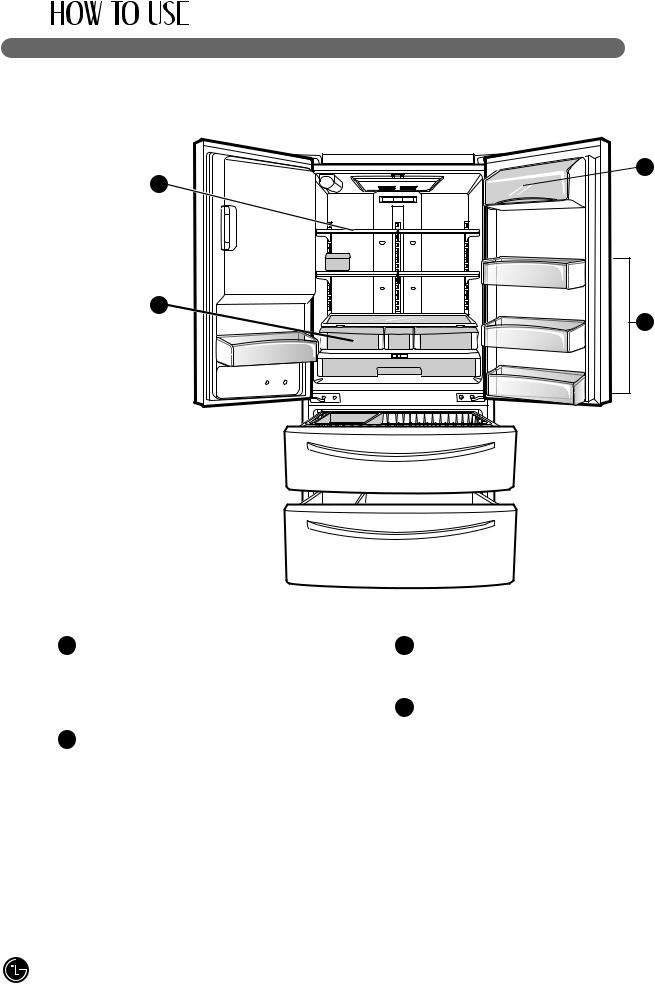
 LOCATION OF FOODS
LOCATION OF FOODS
|
1 |
|
3 |
|
|
|
|
|
2 |
|
4 |
|
|
|
|
1 |
|
3 |
CORNER |
|
Store larger food items, platters, and containers |
|
Store milk products such as butter and cheese. |
|
on the expansive refrigerator compartment |
|
|
|
shelves. |
4 MODULAR REFRIGERATOR DOOR BINS |
|
|
|
||
2 |
CRISPERS |
|
Store small packed food or beverages such as |
|
condiments, salad dressings, baby foods, milk, |
||
|
Store vegetables or fruits with humidity control. |
|
or juice. |
